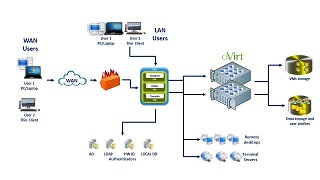Once the previous phases have been completed, we find a robust and efficient virtual desktop platform that is prepared to administer and manage the virtual desktops deployed on oVirt, with the virtual desktops now ready for users to connect to them. By integrating with oVirt, a completely Open Source virtual desktop management and administration solution is achieved.
The oVirt / UDS Enterprise solution incorporates a series of characteristics and functionalities that make up a unique virtual desktop platform
-UDS Enterprise uses differential disk technology to deploy template-based virtual desktops. Using these types of disks in the virtual desktops guarantees a better management of the virtual desktops, since the modifications and updates will be made to the base template. At the same time, storage space is saved because only the changes made to the base template are saved in the differential disks.
-Using oVirt helps you achieve a greater concentration of virtual desktops when compared to other hypervisors, thanks to its resource management and optimization.
-oVirt uses memory management technology, memory overcommitment, allowing for the assignment of more virtual memory to the virtual desktops than the physical server actually has available.
–Load balancing, using the different physical servers of the platform according to different resource usage criteria.
-oVirt permits the usage of local server hard drives that make up the virtual platform as a single shared storage, which results in a cost savings regarding storage.
-Management of the virtual desktop lifecycle.
-Virtual network management, permitting the deployment of virtual machines on different vSwitches, and the configuration of different network interfaces on the virtual desktops.
-The SPICE connection protocol helps achieve an extraordinary user and multimedia experience with low consumption of bandwidth.
-The platform purchasing costs are drastically reduced, as they are substituted by maintenance and support costs.
UDS Enterprise with oVirt is a reliable, efficient and lowcost solution for managing virtual desktop platforms for any type of environment, maintaining all of the characteristics of the hypervisor chosen for your platform.
For more information, read this white paper.








0 Comments